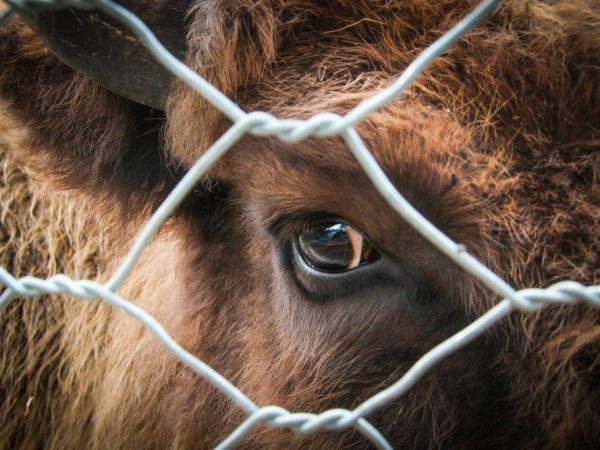What is a calf thorn
The cornea of the eyes of cows and calves, as well as other representatives of cattle (cattle), is an important element of their organ of vision. Occupying about 20% of the entire area of the eyeball, this membrane performs an important function for vision of protection from external stimuli. In addition, it is the cornea of the eye that is responsible for the refraction of light rays. This department, which is important for vision, can be subject to inflammatory processes. One of the most common diseases of this type is thorns in calves and cows.

Belmo at a cow and calves
Causes of eyesore in cows
Belmo appears in a cow for various reasons. Scar tissue becomes inflamed most often due to mechanical damage to the cornea. Any small particles can enter the calf or cow's eye and damage the thin stratum corneum. In addition to injuries received from the outside, this disease can also manifest itself due to parasitic helminths. With such a pathology as thelaziosis, worms attack the visual department of cattle. The eggs of these parasites enter the animal organism with the help of their main carriers - flies. For infection with thelaziosis, it is enough for the infected fly to sit on the corner of the animal's eye.
What else can cause inflammation of the cornea in cattle, you can ask your veterinarian. Sometimes, in order to establish the exact causes of this pathology, specialists take samples of the animal's serous secretions for research, because this is the only way to choose suitable methods of therapy.
Symptoms of pathology
Whatever the cause of the inflammation, a thorn in cattle is easy to recognize. In the early stages of pathology in a calf or in an adult cow, the following are observed:
- signs of profuse lacrimation;
- photophobia;
- conjunctivitis;
- conjunctival hyperemia.
The eyelids become swollen, causing the eye to close or completely close. Serous-purulent discharge is also observed. Most often, it is during this period that the cornea of the eye becomes cloudy in the cow. Both the stratum corneum itself and the blood vessels that are located inside the organs of vision become inflamed. Severe hyperemia leads to protrusion of the eye, and a dark thorn is formed on its surface.
Features of the treatment of eyesore in cows
Ask your veterinarian about how to treat a cow's thorn. It is to him that you should turn to when the animal has signs of inflammation of the cornea of the eye. In order not to harm the health of the cattle, it is not worth taking up treatment without the help of specialists. But there are also exceptions.
Some veterinarians advise livestock breeders to use some alternative therapies. One of these is the treatment with powdered sugar. This will require:
- Take granulated sugar.
- Grind it in a coffee grinder until it turns into powder. This must be done carefully so that no large solid particles remain in the dusty mass.
- Blow the resulting powder into the inflamed eye.
Some breeders recommend not blowing in the powder, but placing it under the lower eyelid.
The procedure should be done 3-4 times a day. According to the reviews of experienced livestock breeders, a calf or cow will have a thorn in the eyes in 5 days. Experts only partially confirm this. Fast recovery times are impossible due to extensive redness of the eye. For several days of therapy, only the clouded area itself fades, but the cornea remains covered with erosions and ulcers. Even with the most effective treatment, it will take at least 1 month for livestock to recover.
Medication treatment
Treating cattle for eyesore will be most effective when treated with veterinary drugs. If the cause of the pathology is helminthiasis, the veterinarian should prescribe antiparasitic treatment. Only after it, the cow's thorn should be treated with local medications. The most effective means are:
- one percent chlorophos solution;
- tetracycline ointment;
- lotions from dandelion infusions.
A solution of chlorophos is instilled into the prone to inflammation of the eyes, 3-4 ml. Treatment will be most effective if, in addition to rinsing, lubricate the eyelids of cows or calves with tetracycline ointment 2 times a day. You don't have to think about where to put the rest of the ointment, since the thorn rarely goes away in a few days. The cow should be treated under the close supervision of a veterinarian, strictly following all his requirements and instructions.
How to protect cows and calves from disease?
It is not difficult to cure cows from thorns, but the therapy itself is long-lasting, which brings its own inconvenience to both sick cattle and its owner. To avoid such problems, it is necessary to use the prevention of thorns. Routine daily inspections of the livestock will help to identify a sick cow in a timely manner and isolate it from the rest of the herd, because if, in addition to a thorn in a sick cattle, there are signs of infectious conjunctivitis, the pathology can be transferred to other cows.
Livestock breeders should also carefully remove prickly objects from the main area of keeping and walking livestock. Even if there is uneaten food in the barn, it should be removed. Feeding can be attacked by the vectors of thelaziosis - insects, so the timely disposal of uneaten food is so important.
It is equally important to conduct regular scheduled examinations of animals and their vaccination by specialists. Sometimes such measures help to identify cloudiness in the eyes at an early stage of onset, which is important for the speed and effectiveness of subsequent therapy.


